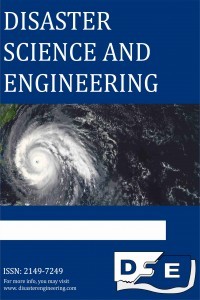Seismic Characterization of the Blast Occured In Istanbul (Turkey) by the end of 2016
Seismic Characterization of the Blast Occured In Istanbul (Turkey) by the end of 2016
blasts, Istanbul, spectra, time-frequency domain analysis, Turkey,
___
- Ottemöller, L., Evers, L. G. Seismo-acoustic analysis of the Buncefield oil depot explosion in the UK, 2005 December 11. Geophysical Journal International 172.3, 1123-1134.
- Sertçelik, F., Irmak, T.S., Livaoğlu, H., Yavuz, E., Sertçelik, İ., Kurtuluş C. (2016). Spectral Analysis of Recent Ankara (Turkey) Terrorist Attacks, Annual International Conference on Geological and Earth Sciences (GEOS 2016), doi:10.5176/2251-3353_geos16.22.
- Sertçelik, F., Irmak, T.S., Livaoğlu, H., Yavuz, E., Sertçelik, İ., Kurtuluş C. (2017) Seismological Analysis of May 12, 2016 Diyarbakir (SE Turkey) Blast, International Conference on Innovative Trends in Engineering, Technology, Computer and Applied Sciences (ITETCAS), Full Proceeding vol. 2 issue. 7, ISBN: 978-602-6427-34-2.
- URL-1: http://aa.com.tr/tr/gunun-basliklari/istanbulda-teror-saldirisi/703506, Anadolu Agency, last accessed: January 2018.
- Willmore, P. L. (1947). Seismic aspects of the Heligoland explosion. Nature, 160, 350.
- Aleqabi, G. I., Wysession, M. E., Ghalib, H. A. (2015). Characterization of Seismic Sources from Military Operations in Urban Terrain (MOUT): Examples from Baghdad. Bull. Seismol. Soc. Am. 106.1, 23-41.
- Boatwright, J., Fletcher, J. B. (1984). The partition of radiated energy between P and S waves. Bull. Seismol. Soc. Am.74.2, 361-376.
- Chakraborty, A., Okaya, D. (1995). Frequency-time decomposition of seismic data using wavelet-based methods. Geophysics 60.6, 1906-1916.
- Gabor, D. (1946). Theory of communication. Part 1: The analysis of information. Journal of the Institution of Electrical Engineers - Part III: Radio and Communication Engineering, 93(26), 429-441.
- Hinzen, K. G. (2014). Seismic analysis of the accidental WWII bomb explosion in Euskirchen, Germany, on 3 January 2014. Seismol. Res. Lett. 85(4), 825-835.Qamar, A. (1995). Space shuttle and meteoroid-tracking supersonic objects in the atmosphere with seismographs, Seismol. Res. Lett. 66, 6-12.
- Kanamori, H., Mori, J., Sturtevant, B., Anderson, D. L., Heaton, T. (1992). Seismic excitation by space shuttles, Shock Waves 2, 89–96.
- Kim, W. Y., Aharonian, V., Lerner-Lam, A. L., Richards, P. G. (1997). Discrimination of earthquakes and explosions in southern Russia using regional high-frequency three-component data from the IRIS/JSP Caucasus network. Bull. Seismol. Soc. Am. 87.3, 569-588.
- Koper, K. D., Wallace, T. C., Reinke, R. E., Leverette, J. A. (2002). Empirical scaling laws for truck bomb explosions based on seismic and acoustic data, Bull. Seismol. Soc. Am. 92, 527-542, doi: 10.1785/0120000242.
- Livaoğlu, H., Irmak, T. S., 2017. An empirical relationship between seismic bedrock depth and fundamental frequency for Değirmendere (Kocaeli-Turkey). Environmental Earth Sciences, 76(20), 681.
- Murphy, M. M., Westman, E. C., Iannacchione, A., Barczak, T. M. (2012). Relationship between radiated seismic energy and explosive pressure for controlled methane and coal dust explosions in an underground mine. Tunnelling and Underground Space Technology, 28, 278-286.
- Nechtschein, S., Bard, P. Y., Gariel, J. C., Meneroud, J. P., Dervin, P., Cushing, M., Gaubert, C., Vidal, S., Duval, A. M., 1995. A topographic effect study in the Nice region. In Proc of 5th Int Conf on Seismic Zonation.
- Yayın Aralığı: Yılda 2 Sayı
- Başlangıç: 2015
- Yayıncı: Emrah DOĞAN
Long Period Seismic Waves Developed at Local Distances
Esra Kalkan Ertan, Ali Pınar, Ümit Dikmen
Analyzing the Effect of Infill Walls on a RC Structure
Murat BİKÇE, Osman Fatih BAYRAK
Effetcs of Near-Fault and Far-Fault Ground Motions on Cable-Stayed Bridges
Hayrettin Karaca, Kurtuluş Soyluk
2011 Van Earthquakes: Design vs Construction
Seismic Characterization of the Blast Occured In Istanbul (Turkey) by the end of 2016
Hamdullah LİVAOĞLU, Evrim YAVUZ, Fadime SERTÇELİK, Tahir Serkan IRMAK, İbrahim SERTÇELİK, Cengiz KURTULUŞ
